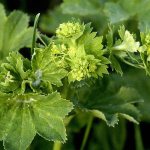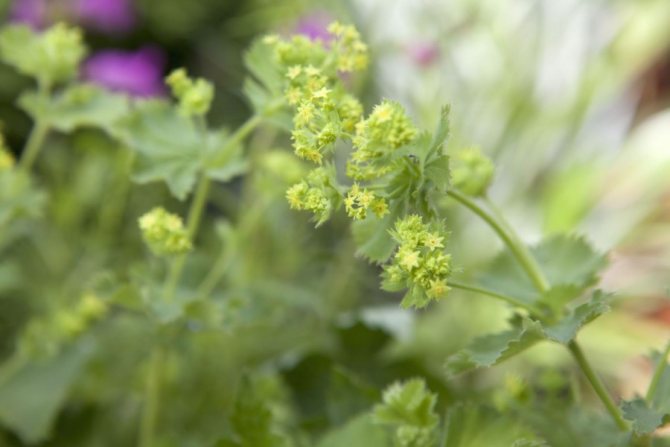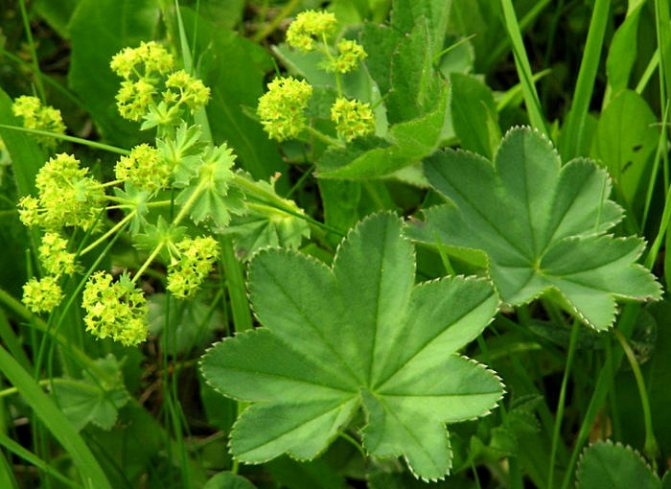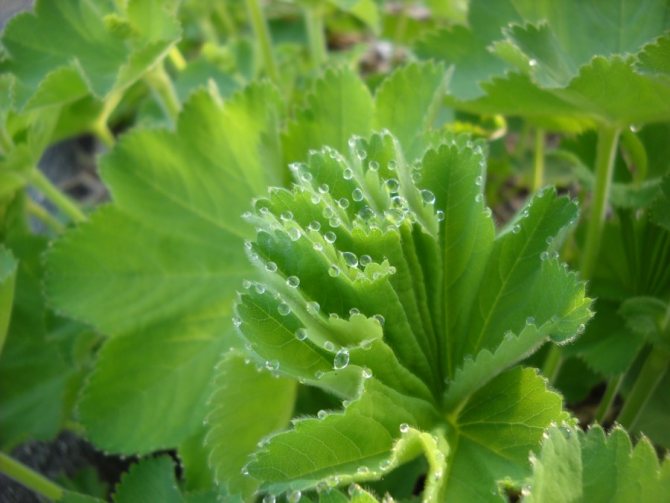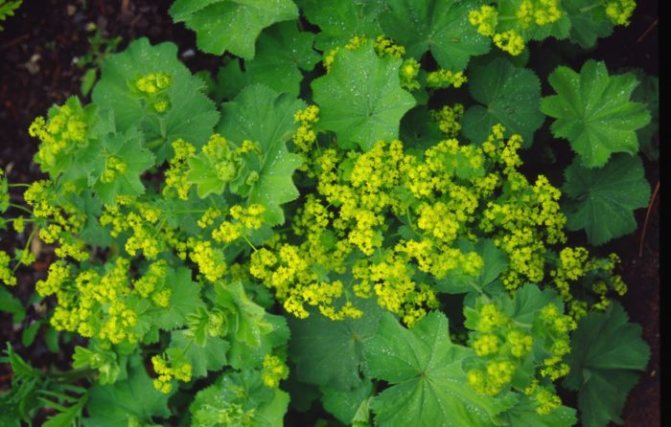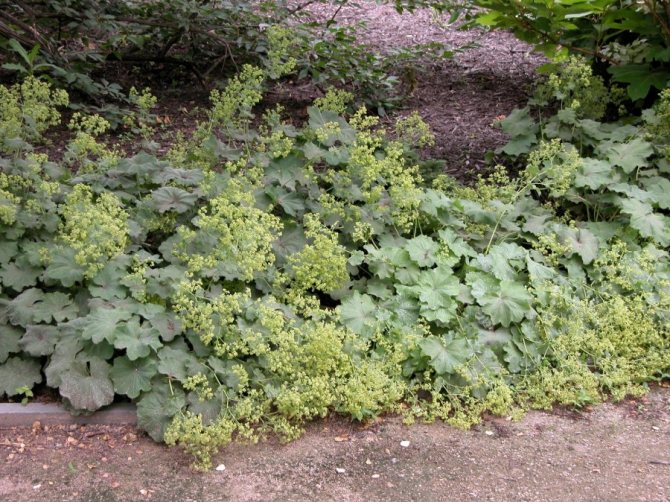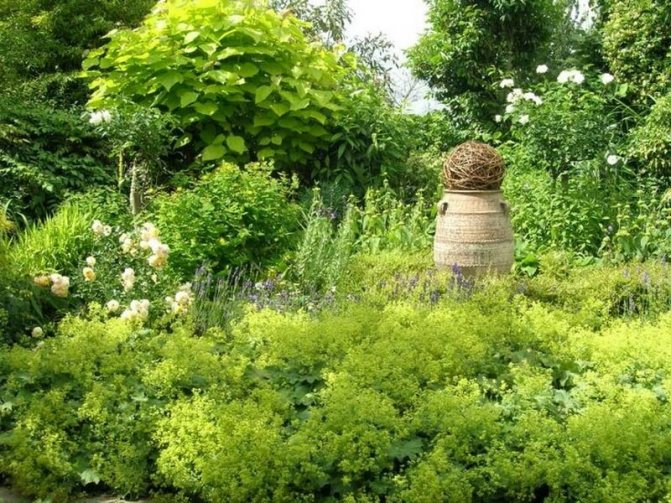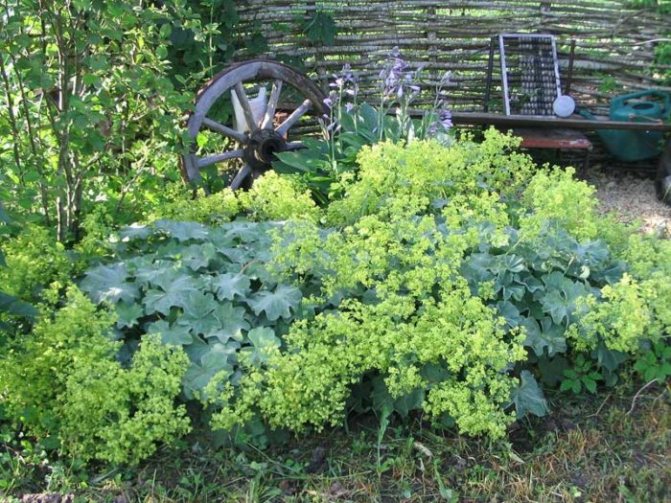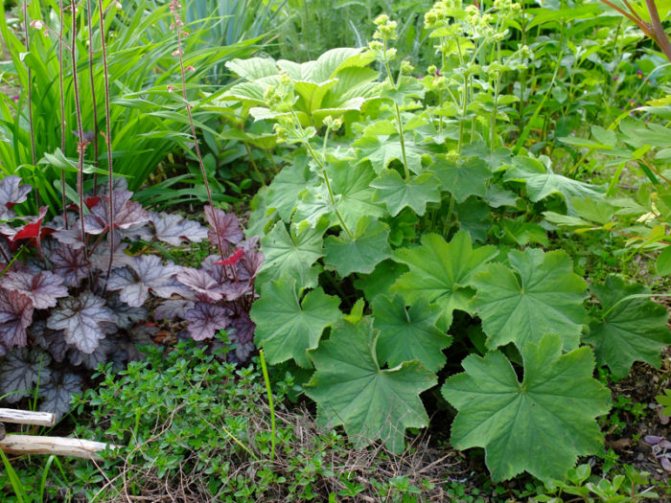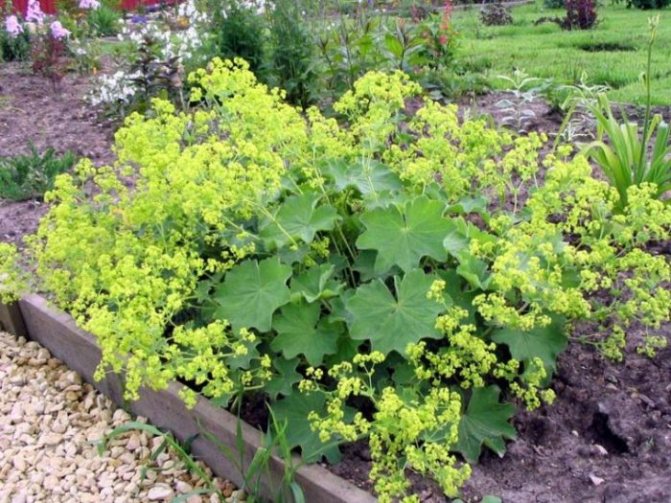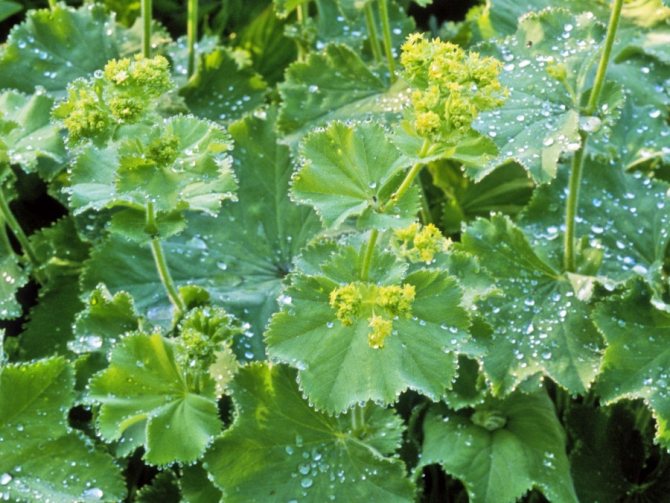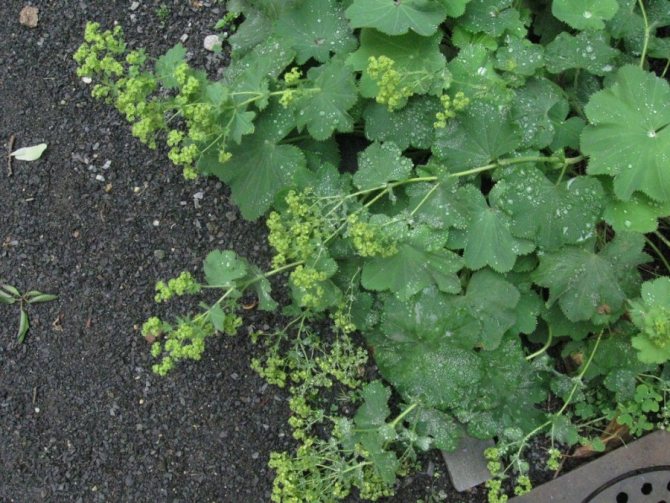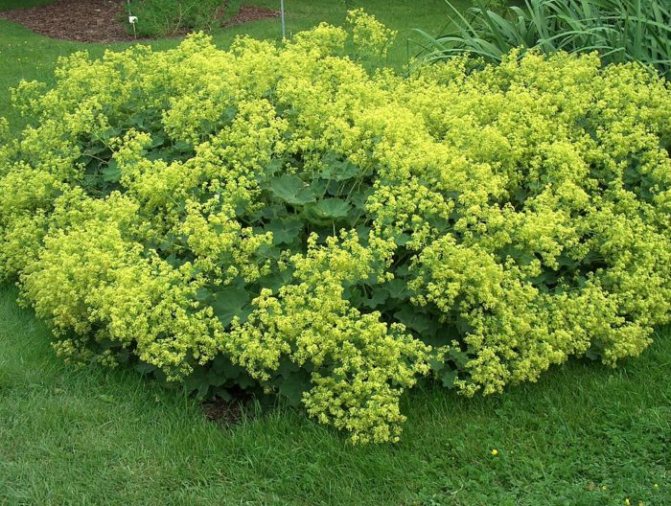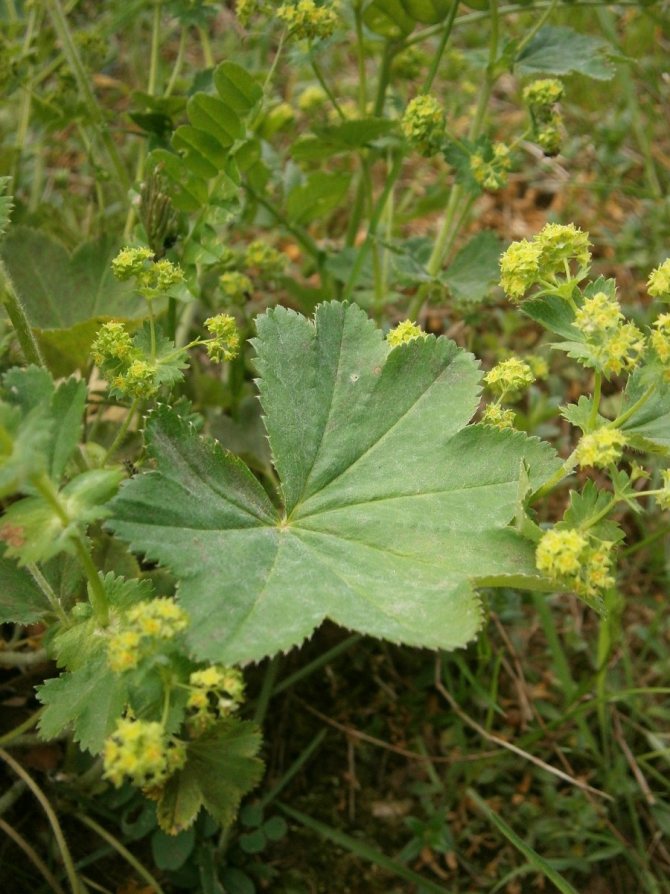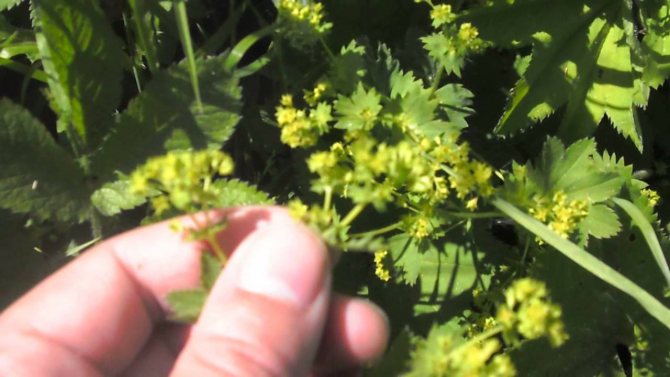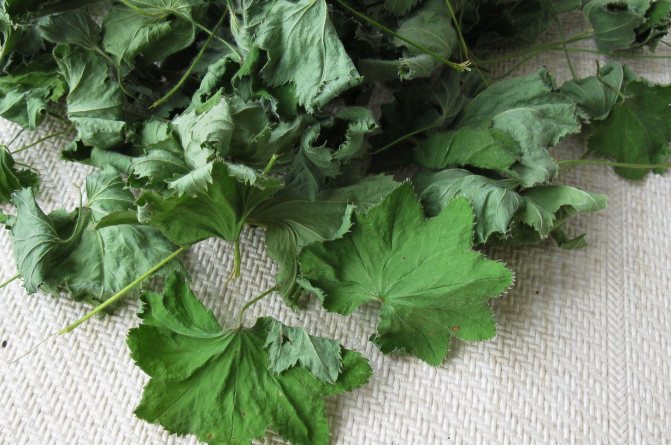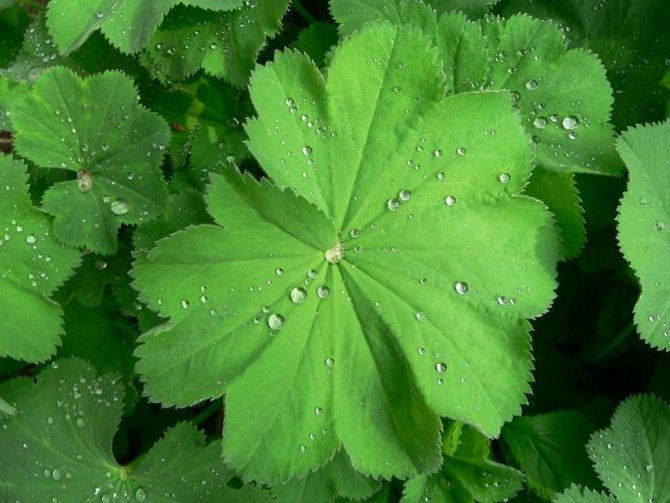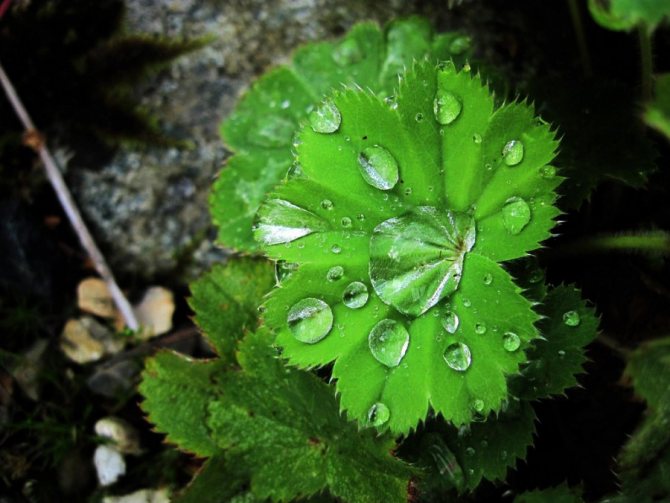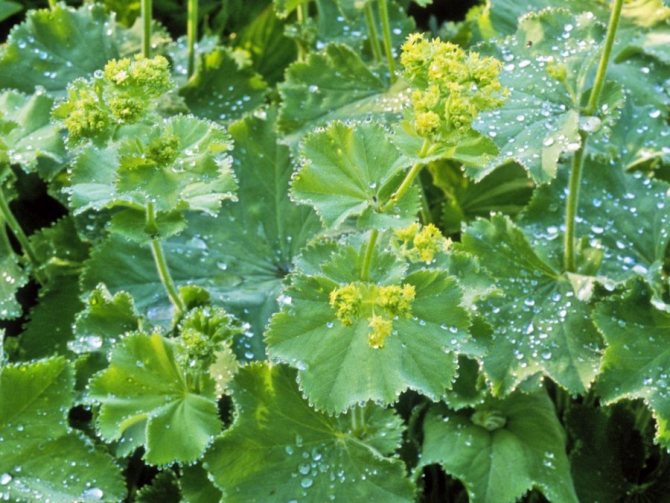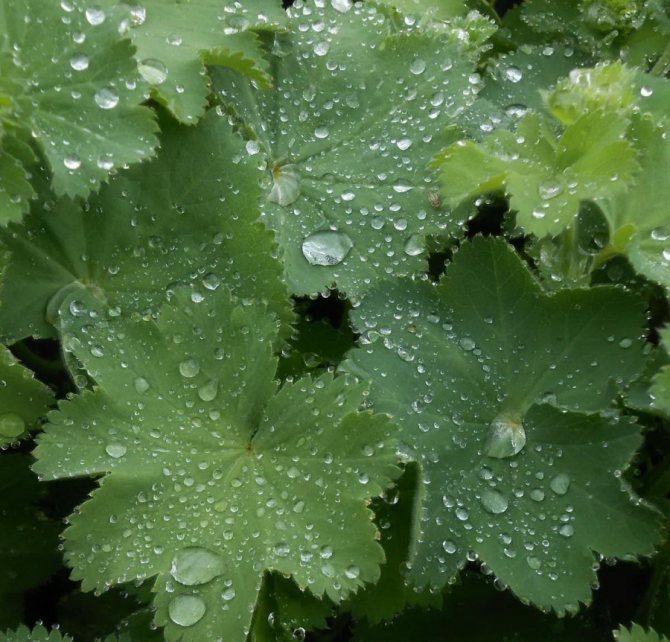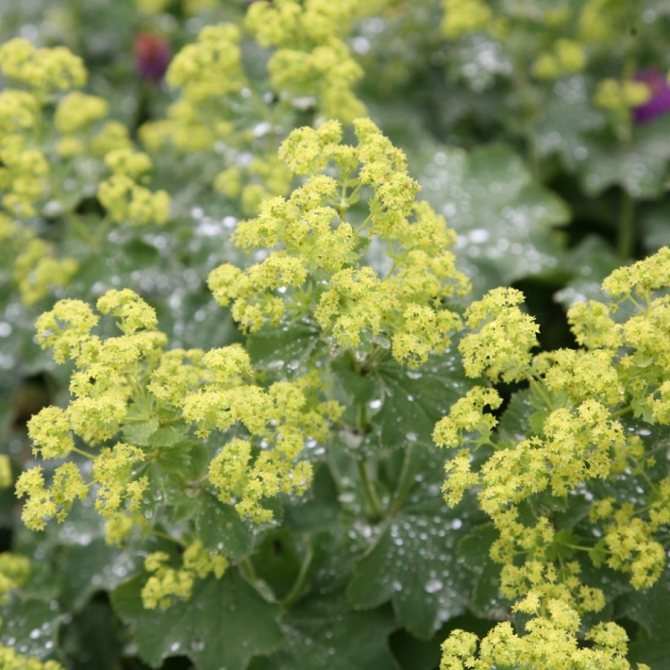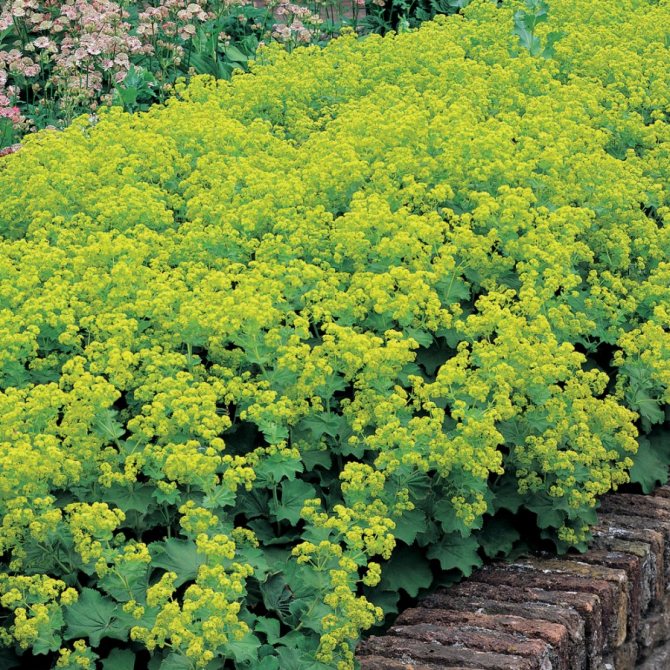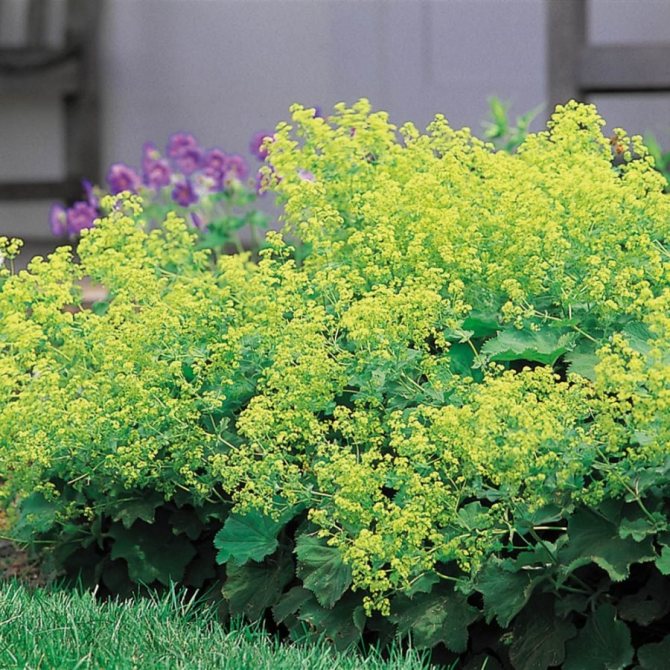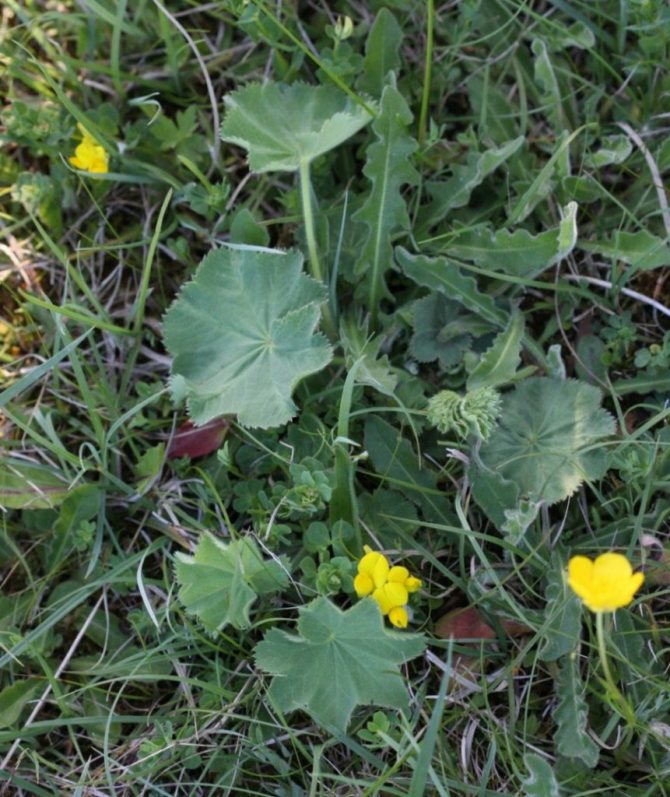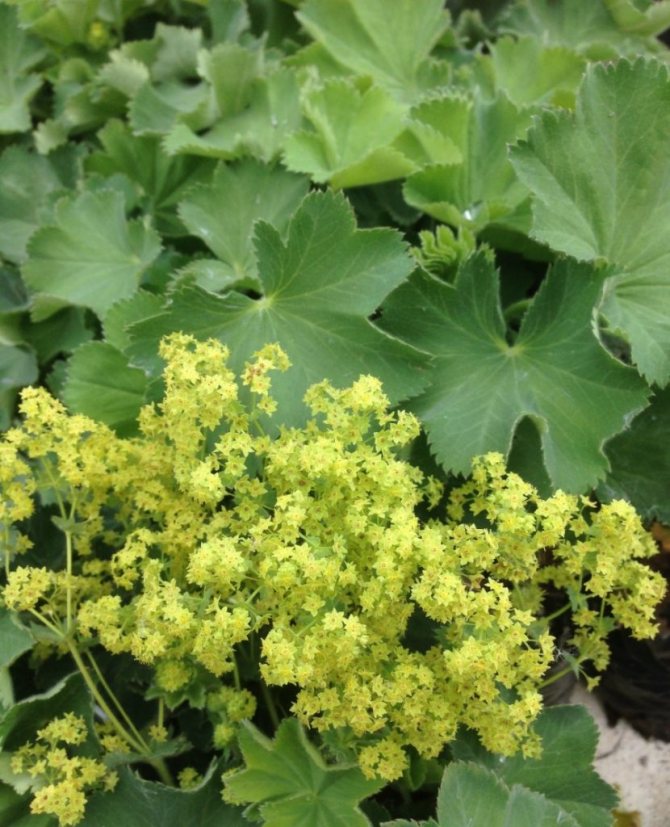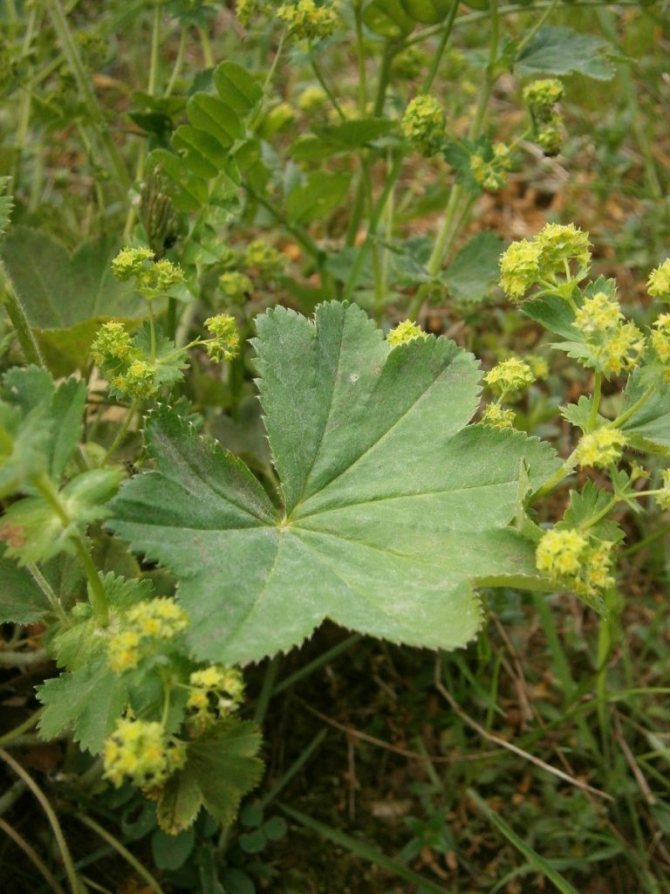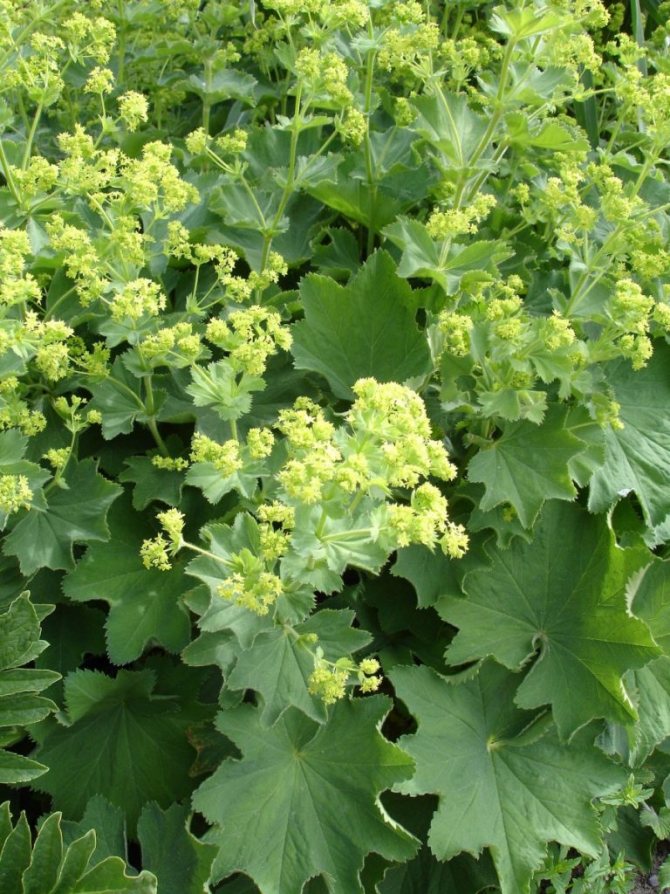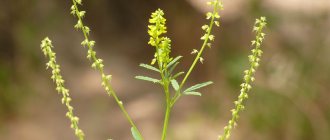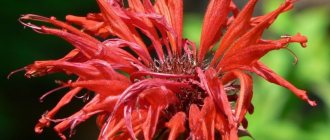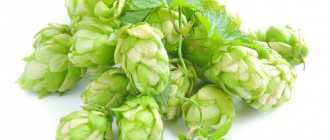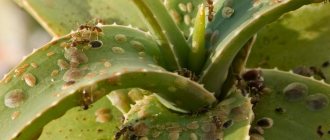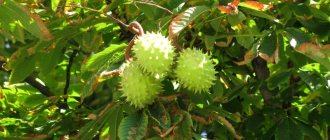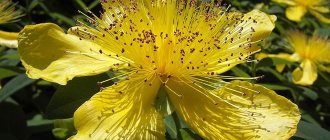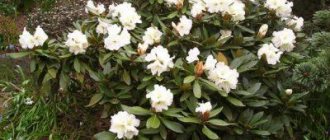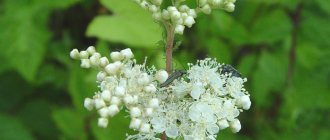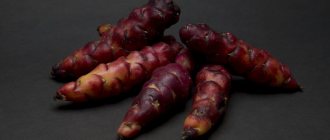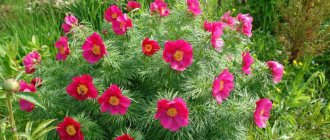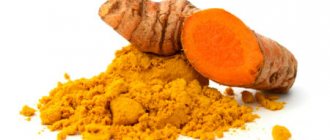Ordinary cuff - a plant of the Rosaceae family.
Latin name: Alchemilla vulgaris L.
Other names: ram, god's tear, heavenly dew, eyelash, dewberry, kamchuzhnik, lion's foot, hare cabbage, star grass.
There are about 40 types of cuffs, but they are all very layered on top of each other and practically do not differ in their properties.
What kind of grass is the cuff, a description of what it looks like and where it grows, photo
Ordinary cuff Is a perennial plant belonging to the Rosaceae family. The grass got its name for the similarity of leaves with frills, cuffs of high-ranking persons. Has creeping stems and color from yellow-green to pure saturated green. It reaches a height of 35-70 cm. The flowers of the cuff are yellow, and are collected in small inflorescences. The fruits of this plant are cupped nuts.
In the middle of this plant, moisture often accumulated from the dew that fell during the night, our ancestors endowed this liquid with the magical power to restore youth and beauty and called it a "god's tear".
The cuff has many small seeds. The peak of flowering occurs in early summer, June, and lasts until the end of August. Sometimes there is also a second bloom of the cuff - in the fall, warm September is ideal for this. Reproduction takes place by self-sowing or through the root system.
You can meet this plant in all CIS countries. In Russia, including. An ordinary cuff (it is also called "female grass" for its invaluable qualities for the female body, widespread use in gynecology) does not like dense forests, river banks, meadows. Sometimes it is grown in the household in vegetable gardens for further use in traditional medicine.
Features
The cuff is ordinary - a perennial with green or yellow-green leaves. Height - 30-65 cm. The plant is creeping, the stem is erect or raised. The stem and leaves are mostly covered with small hairs. Basal leaves are rounded with venation, have 7-10 rounded lobes-sectors. Upper - 5-6 blades-sectors. Young leaves of the cuff are located on long petioles, and the stem leaves are on short ones. The thick root is horizontal. The flowers at the cuff of an ordinary are small, yellow, collected in a multi-flowered inflorescence. The fruit is a single nut, placed in a receptacle with a calyx. The common cuff has many small seeds. The plant propagates by seeds or parts of the rhizome. Blossoms in June-August, fruits ripen in July-September. It can bloom twice a year, the second time in the fall.
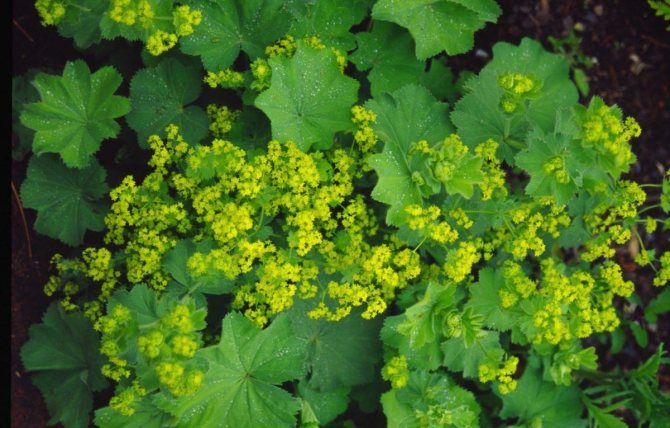
In order not to be mistaken, what an ordinary cuff looks like, take a closer look at its leaves - in their shape they are similar to the paw of an animal, for example, a lion's.
The chemical composition of the herb cuff
The cuff is very rich in vitamin C. Also, it contains many trace elements that are necessary for the full functioning of the body. Among them: manganese, zinc, copper, boron and molybdenum. Sugars, alkaloids, resins, bitterness, tannins, kakhetins, phytosterols, tannins and flavonoids are also found in the cuff herb.
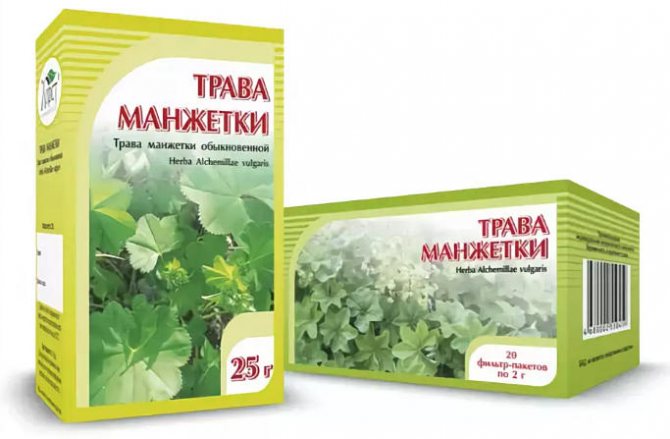

Soft cuff: combination with other plants
In landscape design, a soft cuff is often used in combination with other plants.Many cultures are in perfect harmony with it. For example, wonderful combinations are formed from the cuff of soft and white daisies, blue cornflowers, red geyher, blue delphiniums, etc. They create a very bright decorative cover that requires little or no maintenance.
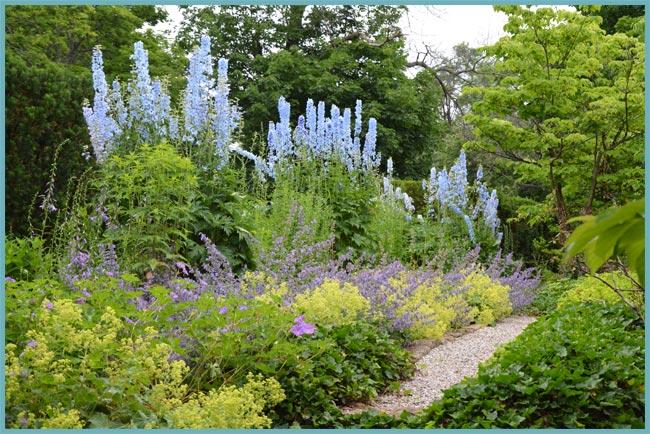

Cuff in landscape design
The healing properties of the cuff
Absolutely all types of cuffs are considered medicinal herbs. An ordinary cuff is no exception. For example, the inhabitants of the Kingdom of Denmark use this plant as a remedy for purulent wounds, ulcers and as a wound healing agent. Italians treat diarrhea and constipation with the plant, and also use it as a diuretic. In Norway, for a long time, the common cuff has been used to treat herpes infections.
The herbal tea is used for sleep disorders, obesity, stress, and fever. Many years ago, the cuff was used as a powerful hemostatic agent for internal and external bleeding.
Also, this plant is known to many as a blood purifier and fighting "bad" cholesterol.
Often, experts prescribe a plant for those who suffer from skin diseases: acne and other rashes can be treated with a cuff.
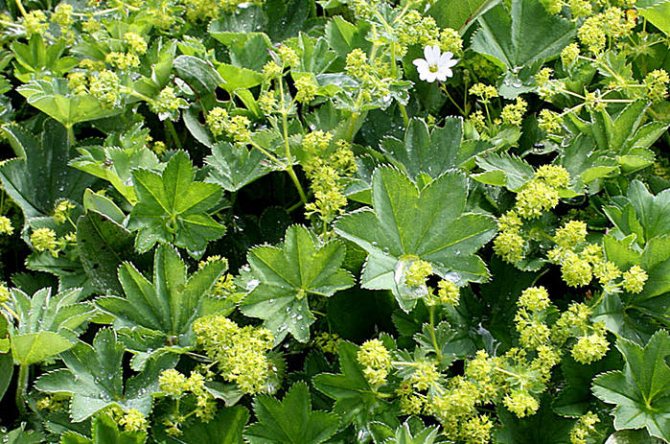

The cuff is soft: features of planting and care, photo compositions in the garden
Earlier, the cuff (Alchemilla, from the Arabic "alchemy") had the fame of a miraculous plant in the branch of alchemy and was a kind of example for architects and designers.
Cuff: description
The foliage of the plant is endowed with the property of guttation, moisture is released through the stomata of the leaves, it is located in small droplets along the edge of the leaf plate, and, interestingly, they do not drain, due to the pubescence and the special structure of the leaf, remain in place, like beads.
Alchemists considered this a miracle and used the dew to prepare the elixir of life and youth. And those who were keen on magic prepared a love potion from the roots of the plant.


The shape of the leaf inspired many architects and artists to create masterpieces, its outlines were the basis of the Gothic style ornaments.
Cuff: varieties and types
The cuff is unique, it cannot be confused with any other plant, in the spring it is one of the first to hatch out from under the snow and serves as a garden decoration until the end of October.
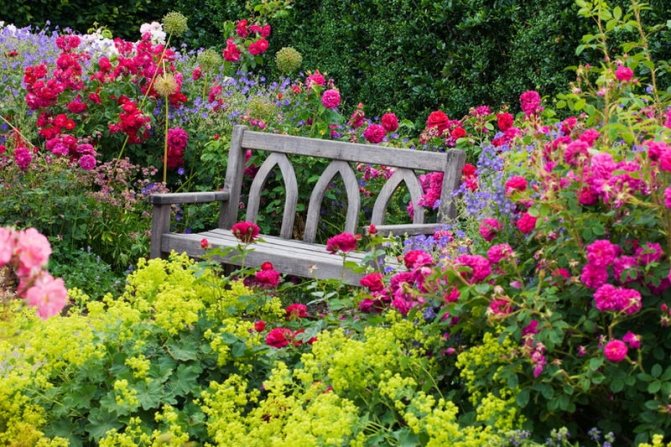

Some species bloom for a long time and profusely, while others are distinguished by the color of the stems and foliage. By the way, palmate, rounded or lobed leaves covered with fine nap are the main decorative advantage of the cuff.
The plant got its Russian name because of the external similarity of the leaf with old starched lace cuffs with scallops. And in Europe, with the advent of Christianity, for a certain similarity of the shape of the foliage with the dress of the saints, the cuff was called the mantle of the Virgin Mary.
In total, there are about 300-350 species practically indistinguishable from each other in nature, in our area there are about 170, and if we talk about popular and widespread varieties, then there are very few of them, but we will single out 5 of them:
Soft cuff (A. mollis)
Creeping herbaceous perennial is a leader in the field of landscaping, most often it is used in decorating gardens and parks.
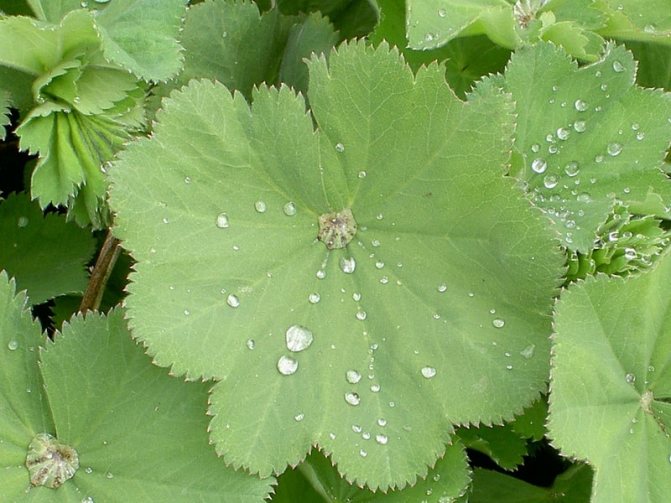

This type of cuff grows up to 40 cm in height, the bush is also about 40 cm in diameter, it grows very quickly, especially on rich, moderately moist, well-drained soils. The soft cuff does not like drought, it can only withstand short dry periods.
Most sources say that this species blooms from the beginning of June to July, and from experience it can be noted that in good conditions the plant will please with flowering already in May, then with timely cutting of the peduncles the next flowering period will begin, it will last until the end of August.
Varieties: Senior, Golden Bouquet, Gold Strike, Thriller.The Robusta variety (Robustica) is distinguished by a more accurate bush shape and large inflorescences. This species includes variegated plant forms used as ground covers to decorate tree trunks.
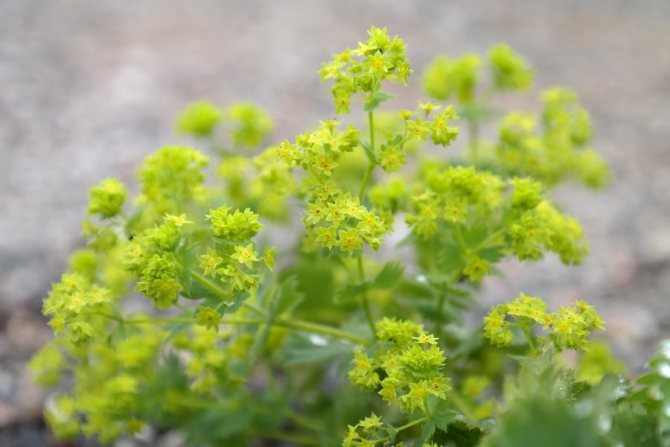

The length of the peduncles can reach 70 cm, but during the period of active flowering, they droop and do not seem so high. In lush paniculate inflorescences, many graceful, small greenish-yellow flowers are collected. The leaves at the cuff are soft fan-shaped, funnel-shaped tapering towards the base.
A winter-green type of cuff that does not need pruning, one could say more - autumn pruning can lead to a subsequent lack of flowering. The soft cuff is propagated during the growing season by dividing the bush, cuttings or seeds.
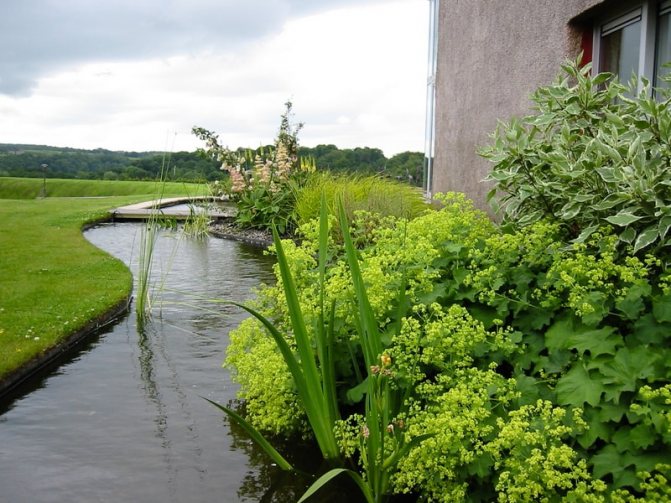

This species grows well both in the sun and in the shade, so you can freely fantasize when determining a place for planting and choosing companions. Good neighbors for a soft cuff will be hosts, ferns, lupins, blue delphiniums and bells, roses, daylilies, etc. Feel free to come up with your options, but keep in mind - the cuff can suppress small, stunted plants.
Miniature alpine cuff (A. alpina)
Neat spherical bushes no higher than 20 cm. The Alpine cuff is distinguished by deeply dissected foliage, with a silvery pile on the reverse side, from above it seems that they are framed by a white border. The plant blooms from mid-May to the second half of June with small greenish-yellow flowers, the alpine cuff can be propagated vegetatively and by seeds.
This species is not bad in rockeries, gravel dumps, or in containers next to bulbous plants - daffodils, tulips, hyacinths, etc. In nature, the alpine cuff grows in humus-rich and calcareous soils.
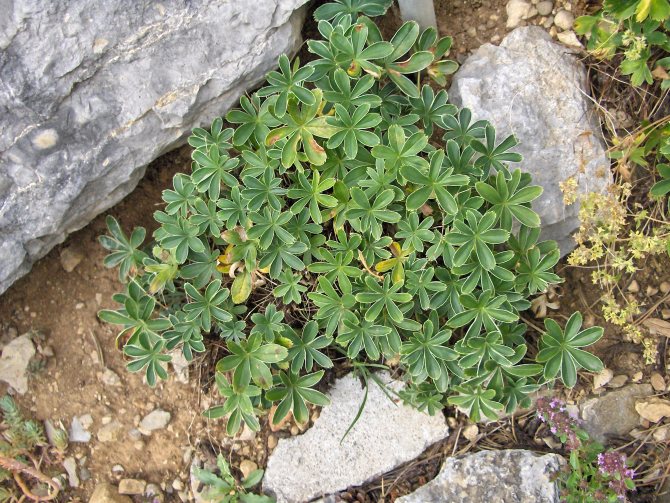

Of the miniature plant species, in addition to the alpine, two more interesting options can be noted - Siberian cuff (A. sibirica)
and
Hoppe (A. hoppeana)
, their maximum height is 20 cm.
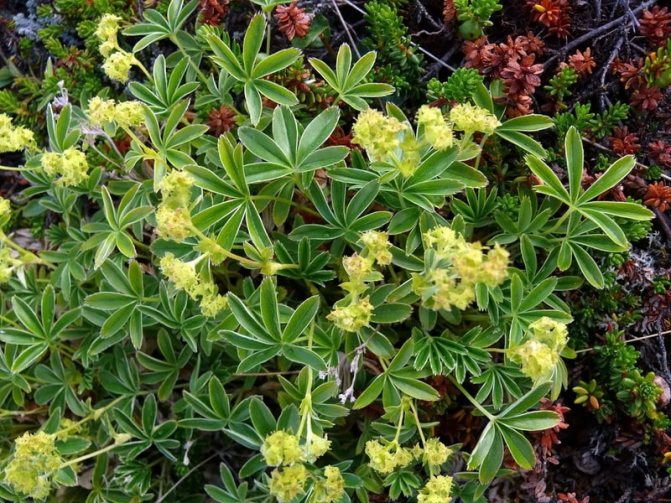

Common cuff (A. vulgaris)
This species has folded leaves, does not bloom profusely from the second half of May to mid-June. Due to the lodging inflorescences, the decorativeness of the entire bush is lost, it looks untidy. The common cuff is damaged by slugs and is a rather aggressive plant, therefore it is rarely used for landscaping.
The common cuff is a plant indicator of neutral and slightly acidic soils.
Red cuff (A. erythropoda)
The species got its name because of the red tint of pedicels, foliage and cuttings. The plant is up to 15 cm tall, the leaves are green with a barely noticeable bluish downy. It blooms from mid-May to almost all of June. Propagated by dividing roots and cuttings. This species can be planted in mixed compositions, as a border and in rockeries.
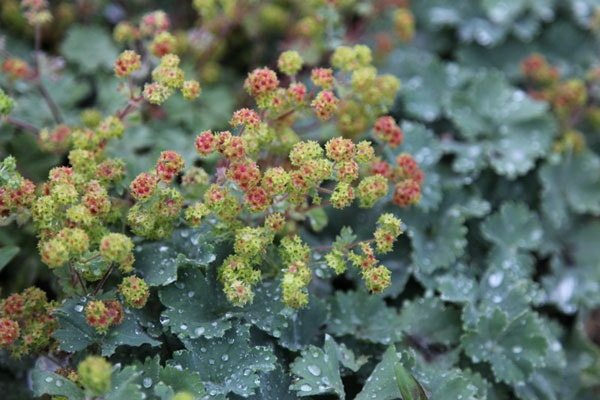

Sparkling cuff (A. splendens)
This species is similar to an ordinary cuff, but unlike it, it grows into a neat bush with erect pedicels. It blooms twice - from May to June and from August to September. Looks good in mixed beds and as a border.
Let us note a few more species according to plant preferences and habitat:
- shaded and damp areas habitat for lunar (A. semilunaris)
and
wave-leaved (A. cymatophylla)
cuffs; - wetlands like cuffs bare (A. glabricaulis)
and
small (A. subcrenata); - bluish (A. glaucescens)
,
mountain (A. Monticola)
and
spherical-crowded (A. Conglobata)
cuffs love open spaces and are resistant to dry gravelly soil; - cuff tuberous (A. gibberulosa)
has an enviable tolerance for drought and sandy soils; - unpretentious species are considered bristly (A. substrigosa)
and
close (A. propinqua)
cuffs, however, it is worth noting that with a critical lack of moisture, plant stems droop; - mountain
,
bristly
and
graceful (A. gracilis)
the cuffs are quite stable types, they practically do not trample, therefore they are ideal for the lawn.
Cultivation, reproduction and care
There is an opinion that there is no need to take care of the cuff, it grows beautifully by itself. But our experience shows that you should still adhere to some rules for keeping the plant.
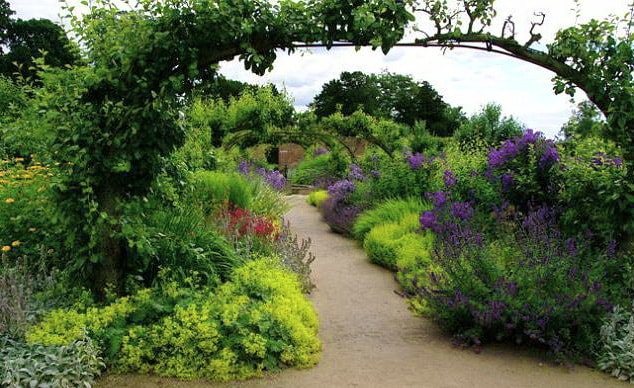

For good development, the cuff needs loose, fertile soil and regular, moderate watering.It is better to choose a place for a plant that is sunny, partial shade is possible. The cuff is a winter-hardy plant, however, winter mulching will not be superfluous, the foliage of large-leaved trees is suitable for this.
Any of all the species presented can become an aggressor, therefore, faded inflorescences should be removed, thereby you will not allow self-seeding. By the way, timely pruning stimulates the next flowering wave.
Reproduction of the cuff
- Division of the bush. It is carried out throughout the season, you should dig a bush, divide it into parts and plant each bush at a distance of 30 cm. The cuff takes root and grows very quickly.
- Cuttings. After flowering (until mid-July), the rosettes along with the heel should be separated from the plant. The removed cuttings need to be rooted in an open moist ground and a shaded place, after 14 days, the rooted bush can be transplanted.
- Seeds. Sowing seeds of the cuff is carried out in the spring in open ground or seedlings are harvested in November. A container is prepared and a wet substrate, in which the seeds are placed, are covered with a thick film. After 14 days, the box, along with the shelter, should be taken out into the street, in the spring, brought back into the room, where the seedlings will hatch together. After three weeks, a pick is carried out and after the formation of a developed root system, they can be planted in the ground.
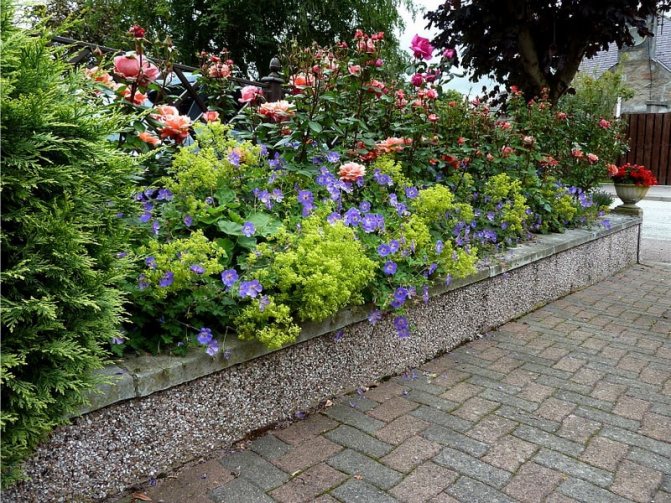

Application in folk medicine of herb cuff
Cuff herb is often used in folk medicine for the preparation of decoctions, infusions, tinctures. They are used to treat many diseases. Especially well, it is believed to be treatable with cuff diseases associated with metabolic disorders.
For example, with diabetes mellitus, doctors recommend taking healing tea with a cuff. It should be prepared in this way: - 30 g of dry medicinal raw materials must be poured with 2.5 cups of boiling water. Let the liquid brew for 15-20 minutes. Strain through cheesecloth and drink throughout the day before eating. The effect will become noticeable after two months of use. However, this tea should be taken longer only under the supervision of a doctor.
Also, traditional medicine has in its reserves a recipe for a medicinal collection, which also helps to normalize blood sugar levels. This collection can be prepared as follows: - cuff herb stalks, sage leaves, strawberries, licorice, lilac buds and dandelion root must be mixed in equal amounts. Pour 50 g of the resulting mixture into a saucepan and pour 0.5 liters of boiled water over it. Cook over low heat for no longer than 5 minutes. Then pour the collection into a glass jar, wrap it in a warm towel and leave for 2-3 hours. Then strain and take 3 tablespoons 20 minutes before meals.
The plant is very good for those who suffer from the problem of cystitis. Our grandmothers also used the recipe for this broth. To prepare the broth you need: - take 35 g of dry cuff herb and pour 350 ml of it. boiling water. Insist for 3 hours. Drink with a spoonful of honey three times a day for a cup, a course of 1 month. It is worth repeating the course no more than once a year.
Often, experts recommend cuff herb for colitis. It will not be possible to get rid of the problem completely, however, an infusion based on a cuff can greatly alleviate the condition. - to prepare an infusion of 20 g of a dry cuff, pour glasses of boiling water and leave for 2 hours. We filter and take 50 ml three times a day.
Inflammatory processes in the kidneys also respond well to treatment with this truly healing herb. Nephritis is known to need to be treated under the supervision of a specialist. But doctors often prescribe a cuff-based infusion for nephritis. - take a large, deep saucepan, pour 400 ml into it. boiling water and add 35 g of dry herb cuff. Simmer for 2 minutes over low heat, then remove. Leave alone for 2-3 hours and drain.Take a glass in the morning before breakfast and 2 tablespoons in the evening before dinner.
The cuff is able to strengthen blood vessels and have a beneficial effect on the work of the heart. That is why very often doctors recommend preparing a tincture based on this plant, and taking it as an antihypertensive agent. - for tincture you need to take 250 ml. red wine and 30 g dry cuff. Mix and simmer for 5 minutes. Then insist for two days. Then strain and drink 10 ml each. before every meal.
Diseases of the gastrointestinal tract are treated with a variety of drugs and herbs. Cuff grass also belongs to such plants. It, in combination with other raw materials, copes with the high secretion of gastric juice.
To prepare a collection that copes well with gastritis, you need to take: - the same amount of centaury grass, knotweed, mint, motherwort and cuff. Pour raw materials into a thermos and pour 600 ml. thick boiling water. Screw the lid back on tightly and leave to infuse overnight. Strain the finished infusion and drink 50 ml before each meal.
Constipation is often accompanied by stomach pain and indigestion. The cuff will help in this case.
It is unpleasant to talk about hemorrhoids even with a doctor. Therefore, many people avoid going to the hospital to the last. However, you often have to fight this disease on your own, preparing various infusions, decoctions, teas. The cuff also works well for many of the symptoms of hemorrhoids. It must be properly combined with other herbs and then the effect will not keep you waiting long. - we take a dry cuff, blackberries, strawberries and plantains. We mix everything in the same proportions. We select 15 g of the finished raw material and fill it with 350 ml. steep boiling water. We insist in a glass container for 3-4 hours. We filter and take half a glass in the morning.
A cuff-based tea recipe that is beneficial for hepatitis. - 10-15 g of raw materials pour 150 ml of boiled water. Insist for 10-15 minutes and drink a glass daily.
In the presence of thyroid disorders. The cuff normalizes the balance of hormones in the body well, thereby improving the functioning of the thyroid gland. - we take 25 g of raw material cuff, lemon balm, calendula, plantain and burdock. Mix everything and pour 400 ml of boiling water. We insist for 2-3 hours. We filter and take 30 ml. three times a day.
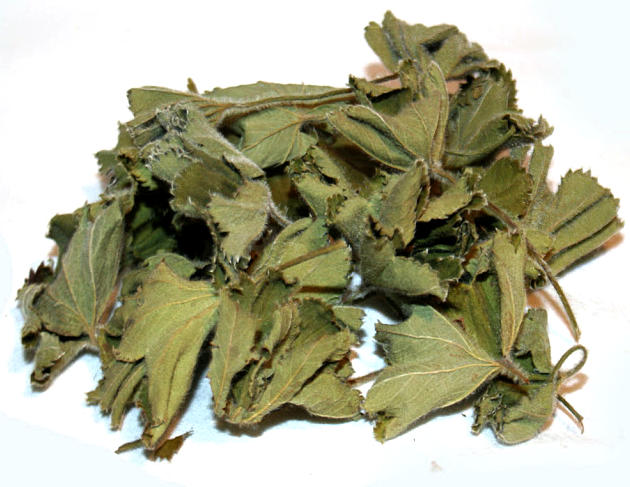

Care
The cuff loves watering, but does not tolerate stagnant moisture at the roots. In dry summers, watering may be required almost daily. Mulching the soil surface around the bushes with peat or deciduous tree bark will help to facilitate the task of retaining moisture.
To avoid unwanted self-seeding of the cuff, the faded peduncles must be cut off. At the same time, the pruning of unnecessary shoots and the pinching of the branches are carried out to form the bush.
For the winter, the culture does not need to be covered, it winters well in the middle lane.
If a complex mineral fertilizer or rotted manure with wood ash was introduced into the planting holes, then there is no need to feed the plant with anything for 2 years.
In the future, fertilizing will be required twice a season. At the beginning of the growing season, in spring, the bush is mulched with humus or compost. In the middle of summer, a liquid top dressing is applied with any mineral fertilizer.
Under unfavorable climatic conditions, the cuff can get sick with rust, powdery mildew, black leg.
Cuff in gynecology
Naturally, the female herb is in great demand for pathologies of the female genital organs. The cuff treats diseases of the uterus, appendages, mastopathy, female infertility, is used to normalize the menstrual cycle, with dysfunctional uterine bleeding, heavy or painful periods, the plant relieves the symptoms of the onset of menopause.
For a hemostatic effect with uterine bleeding, you need to take 8 teaspoons of dry grass and brew with two glasses of boiling water, let it brew for half an hour, strain, drink 2-3 times, distributed evenly throughout the day. It may take several days of administration, depending on the severity of the condition.
Starting from the 14th week of gestation, gynecologists recommend drinking tea with a cuff to prevent the threat of miscarriage, to prepare the mother's body for future childbirth (their easier passage), this herbal tea prevents postpartum complications, reduces the increased anxiety of the pregnant woman.
The dose of the product is less than in the previous recipe, for brewing you need 2 teaspoons per glass of boiling water. You can drink 1-2 cups of this tea a day.
For nursing mothers, the cuff herb is also very useful - it increases lactation and stops postpartum bleeding.
With infertility, the plant not only helps to treat various kinds of inflammation of the female genital organs, it also stimulates the production of progesterone, with a low amount of which in the body, conception is very problematic. Drink infusions in the luteal phase of the menstrual cycle, namely from 15 to 25 days.
It's important to know! When treating with herbs with an effect on hormonal levels, you cannot combine them with other drugs or drugs of a similar effect, they drink them for a long time (three cycles, then a break cycle, and, of course, skip menstruation). The effect is not visible immediately, but after 2 or even 3 weeks after the start of treatment. Therapy should be controlled by hormone levels.
Very often women are faced with the problem of thrush. And in this case, traditional medicine invented a cuff-based remedy for tea and douching liquid. - to make tea, you need to pour 5 g of herbs with a glass of boiling water and leave for 10 minutes. Drink twice during the day. - to prepare a solution for douching for genital candidiasis, you need to take 15 g of dry chamomile flowers, 15 g of dry grass cuff, mix these two components and pour 400 ml. steep boiling water. Put in a water bath and stand for 20 minutes. Then strain thoroughly and cool to room temperature. Use as douching solution.
The internal intake of the described herb also helps to increase the breast, of course, it is not able to increase from 1 size to the 5th, but an increase of one and a half in a three-month course can be expected. They drink a remedy for this purpose on a monthly basis, with weekly breaks, for this they brew a dessert spoon in a glass of boiling water, insist, filter and drink in two steps.
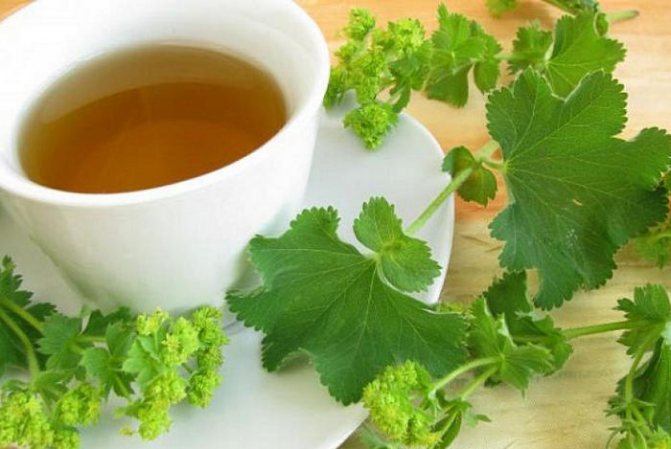

Reproduction and transplantation
The plant propagates in several simple ways. Among the most commonly used are the following:
- Seeds... The seeds of the plant are sown in moist soil in early November. After two weeks, the boxes are taken out to insulated greenhouses and left there until the beginning of spring. In the spring, the boxes are brought into a warm room, where the seedlings sprout quickly. After 3 - 4 weeks, young plants dive, planting each plant in a separate box until the root system develops. The hardened plant is planted in open ground.
- Cuttings... After flowering, cuttings with a heel are separated from the cuff bush and rooted separately in moist soil. For 2 - 3 weeks, the plant is often watered, and after this time is planted in a permanent place of growth.
- Dividing the bush... A healthy overgrown bush in early spring is dug up and divided along with the root system. The distance between the bushes should be at least 30 cm. It is better to fertilize the soil for transplanting with humus.
Each of the above breeding cuffs is easy to use and produces young plants with proper care.
Cuff in cosmetology
The cuffs are also used in cosmetology. In particular, it is used in the fight against cellulite.
Due to the high content of flavonoids, this plant is able to smooth the skin well. So, to get rid of cellulite, you need to prepare a decoction: - Mix 25 g of dry cuff with 15 g of dry parsley. Pour boiling water over the raw materials and leave for 1-1.5 hours. Then strain and pour into a convenient container.Take a tablespoon in the morning and evening.
It is also effective for cellulite to use lotions based on a cuff. To prepare a solution for lotions, you need 30 g of raw materials, pour 300 ml of boiling water and leave for 1 hour. Then strain, and tie the remaining herb into a piece of gauze. Apply gauze with grass to problem areas.
Diseases and pests
Despite the unpretentiousness of the Cuff, the plant is susceptible to the development of such diseases:
- Powdery mildew. The leaves are covered with a white bloom, and after a while they die. The occurrence of such a situation is possible with a lack of sunlight or excessively high humidity. Damaged leaves should be destroyed and the conditions for caring for the plant should be changed.
- Black rust. This disease develops if the plant grows under the dense crown of a tree. To combat the disease, it is necessary to remove damaged shoots and treat the cuff cut with a special solution.
Among the pests that can develop on the Cuff, slugs or snails are most often found. They must be carefully collected from the bush with your hands and treated with a special solution that prevents the development of pests.
It is important to note that the plant needs periodic inspection of the leaves of the bush. This can prevent the active development of diseases and the spread of pests at the very beginning.
Contraindications and harm to the cuff
To date, the cuff has been studied thoroughly and repeatedly. However, there are almost no contraindications to the use of this plant, in addition to pathologically developing early pregnancy, breastfeeding and early childhood. The cuff also does not bring critical harm to the body.
A slight disorder in the work of the gastrointestinal tract and diarrhea may periodically occur, this situation is especially possible in case of an overdose of herbal remedies.
Also, before long-term use of the cuff, it is recommended to take a blood coagulation test, with increased coagulability, it is taken with caution or completely abandoned.
Grass cuff - price
The cost of filter bags with grass cuffs is low, around 60 rubles per pack.
Additional materials
- The cuff is a witch's tool
- There is grass for everyone to hurt
- Hair is the grass in the flower bed of our head
- Endometriosis - the scourge of the modern woman
- Active ingredients of medicinal plants
- Gonadotropic regimens for gynecological diseases
- Where to find the keys to health
- Phytotherapy of polycystic ovary
- Leukemia as a systemic disease
- What herbs can cure mastopathy
- Causes and consequences of menstrual irregularities
- Causes and treatment of uterine bleeding
- Premenstrual tension syndrome - PMS
The best breeding option is seeds.
There are two options for reproduction of the cuff - by dividing the bush or sowing seeds:
- The first method can be implemented both in spring and autumn. For planting, the bush is pre-dug out entirely. This is usually a very laborious and inconvenient process due to the dense interlacing of plant roots. In this regard, the cuff is often propagated through sowing seeds.
- Seeds sown in the ground develop quickly enough, after a year the planting material will be ready for planting. Due to the good germination of seeds in early spring, when the weather is cool, the optimal time for sowing is the end of autumn. A feature of the cuff is the ability to form seeds even without opening the anthers and pollination of the flower by insects (this phenomenon is called apomixis).
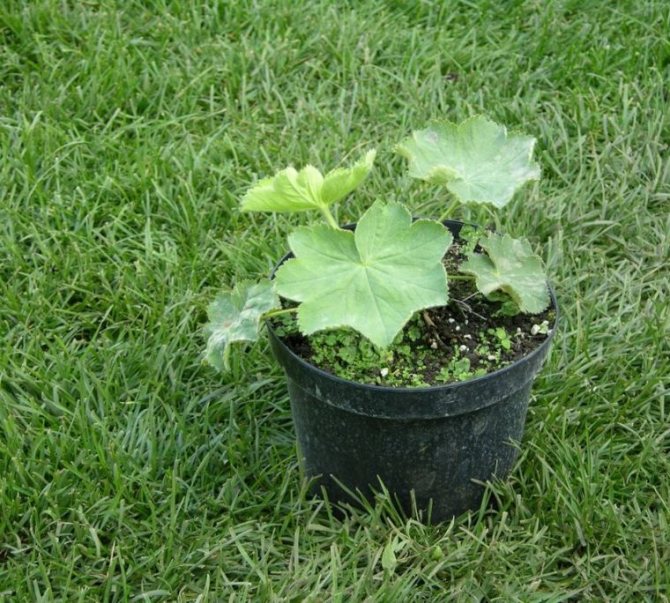

Seedling cuff
With diabetes mellitus
Long since by folk healers, and more recently by official medicine, a cuff has been used to treat a variety of diseases.Its medicinal properties in diabetes are so high that they allow people suffering from this very unpleasant disease to significantly lower blood sugar without drugs. In the early stages of diabetes, the effect of cuff treatment is unique. With its help, not only sugar returns to normal, but also improves the condition of the skin, normalizes the work of the digestive tract and pancreas. The recipe for the medicine is unusually simple: you just need to brew the cuff like regular tea and drink it daily. You can also prepare a mixture of cuff, lilac buds, dandelion and licorice roots, lingonberry and sage leaves. The only thing that diabetics should not forget is that drugs with a cuff have a negative effect on blood coagulation, so before you start drinking tea with this herb, you need to pass the appropriate tests.
In what cases is the plant used?
The variety of healing effects makes it possible to use the herb in a fairly wide range of different conditions:
- Formations with ulcerative processes in the digestive tract.
- Conditions characterized by decreased peristalsis.
- Colitis, enterocolitis of various origins.
- Conditions characterized by diarrhea, inflammatory manifestations of the liver tissue.
- Respiratory system pathology, including tuberculosis infection.
- Inflammatory changes in the organs of the urine excretion system.
- Diseases associated with metabolic disorders.
- Cardiac pathology, atherosclerotic phenomena.
- Diseases of a gynecological nature, severe menstrual bleeding.
- Varicose veins.
- Autoimmune diseases and connective tissue pathology.
- Nervous disorders, sleep disorders.
Is a cuff useful to everyone?
You will be surprised, but almost everyone, without exception, can use the cuff as a preventive or herbal medicine.
Particular attention should be paid to the component composition. In case of individual intolerance or hypersensitivity to one of the ingredients, allergic reactions may occur. The rest of the cuff is an absolutely safe herbal remedy.
On a note! The maximum permissible daily dosage and the duration of the course of treatment must be agreed with a specialist. Otherwise, disturbances in the functioning of the digestive tract may appear in the form of diarrhea or constipation.
Cuff tea
It is necessary: One teaspoon of herb is enough for a cup of hot water. Let it brew for 10 minutes. Tea can be taken in a cup 3 times a day.
Application area: It is recommended to drink with diabetes mellitus, to improve the lactation of breast milk in women, to cleanse the body.
On a note! Tea can be drunk with obesity. It will help remove excess fluid from the body, normalize metabolism, which contributes to weight loss (with active physical activity).
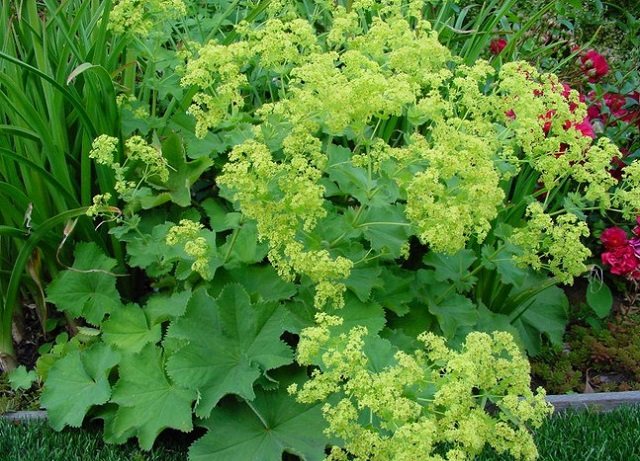

Grass cuff
Cuff decoction
It is necessary: Pour 4 tablespoons of chopped herbs with a glass of hot water. Simmer on minimum heat for no more than five minutes after boiling, let it brew for about two hours or until it cools completely. Strain. Take 1/2 cup 3 times a day. You can add a spoonful of honey or a little sugar to improve the taste. Outwardly used in pure form.
Application area: Topically used to treat acne, eczema, weeping wounds, boils. Inside it is recommended to take for treatment - bleeding, cough, gout, rheumatoid arthritis, various inflammatory diseases.
What is the plant afraid of?
This herbaceous perennial is quite disease-resistant. In some cases, when planting a cuff under woody plants, the leaves can be affected by a black leg (looks like rust).
You can fix the problem by simply transplanting the bush to another place.
In addition to the black leg, powdery mildew can affect the cuff.This phenomenon is extremely rare and is possible only when the plant is planted in dry poor soils.
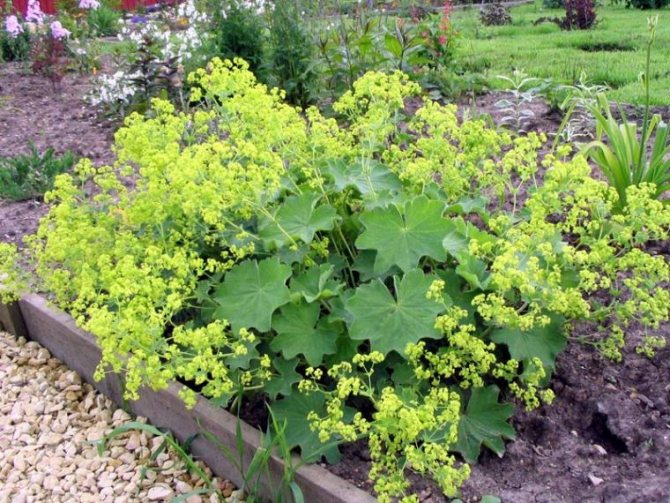

Infusion from the cuff
It is necessary: Pour a glass of boiling water over 3 teaspoons of chopped herbs. Let it brew for at least two hours, strain. Take 1/2 cup before meals 4 times a day. For external use, use pure.
Application area: Recommended for women for douching in the treatment of thrush. Helps speedy wound healing when applied externally. When used internally, it will eliminate inflammatory processes in the body, normalize intestinal motility, and help in the treatment of pulmonary diseases.
Choosing a place for landing
The optimal place for planting soft cuffs are neutral loose soils with a high humus content.
During the preparation process, it is important to ensure the airtightness of the soil and its constant moisture (while dampness should be avoided).
When the plants are planted in organic-rich loams on well-moistened areas under the open sun, care for the cuff is minimized. For better growth, the soil can be pre-filled with compost or humus.
In this case, it is not necessary to feed the plant for a sufficiently long period.
From our article you can learn how to make a rocking chair with your own hands - detailed drawings, master classes and tips. Country plant astilba: planting and care, propagation by cuttings and seeds, pests and diseases, which have to be combated. Read about this and much more here.
Collection, preparation, storage of the cuff
You can start harvesting the green part of the grass at the end of May until the end of September. Some traditional healers also use the roots of the plant, which can be dug out at the end of September.
It is better to collect in the daytime after the dew dries on the branches of the plant. The entire ground part is cut off, and the roots are dug up with a shovel. The green part must be sorted out well, discarded spoiled leaves and twigs. Rinse the roots from dirt.
The grass can be hung in bunches or spread out on a flat surface in a dark place. To speed up the process, it is recommended to use electric dryers.
The roots are laid out in an even layer in a dark place, preferably in an attic under a metal roof. For good drying of grass and roots, in addition to heat, good ventilation is also needed, otherwise all raw materials will simply become damp.
After drying, put all raw materials in cotton bags. The grass is stored for about a year, then it starts to taste bitter. Store in a dry, well-ventilated place.
Pharmacy cuff
Morphological description
The stem is branched, reaches a height of 30-40 cm, rises above the ground or erect.
The lower leaflets are reniform, dissected almost to the middle into 7-11 concave lobes. Stem leaves are sessile or short-petiolate. The venation is radial, the edges of the leaves are wavy.
The leaves have a palmate-lobed structure and a memorable rounded shape, reminiscent of a cuff with edging and wavy edges. In the early morning, droplets of moisture can be seen on the leaves, which some confuse with dew.
In fact, this is the excess moisture that the plant itself emits. It is believed that this moisture perfectly rejuvenates and tones the skin, prevents aging: you can drink it, or you can use it instead of a tonic.
Flowers are small, inconspicuous, yellow-green, collected in false umbrellas in large numbers. Flowering occurs over a long period, from June to September.

